Introduction
Competition has intensified in the global markets and companies are seeking better strategies of pricing and developing their products to achieve a competitive edge. Adopting appropriate pricing and product development strategy will improve the position of a company in the market by attracting new customers, retaining existing customers and creating customer loyalty.
In addition, these strategies help regulate costs incurred by a company as well as maintaining profitability (Kurtz, MacKenzie & Snow, 2009). Product-life cycle requires use of different pricing and research and development strategies for products at different stages. This means that during growth stage, shakeout and maturity stages the management should adopt different strategies for pricing and allocation of research and development costs (Stark, 2005).
In this paper the author attempts to provide a report about analysis of three products (Handheld X5, Handheld X6 and Handheld X7) which are manufactured by PDA Sim Company. Pricing strategies adopted by the company and performance of each product in the market have been analyzed.
Analyses about the effect of research and development costs on the strategies adopted by the company have also been explained. A proposal about alternate strategies that should be adopted by the management of the company has been provided towards the end of the report.
Review of the products
Company PDA Sim introduced three products (Handheld X5, Handheld X6 and Handheld X7) in the market. Product X5 has been in the market for three years and customers are responding positively towards this product. The product is at the maturity stage of a product-life cycle and repeat customers tend to exceed new customers. Product X6 was introduced 2 years ago and is at the shakeout stage of the product-life cycle.
Customers for this product are either new customers or repeat customers. Product X7 was introduced a year ago and is at the growth stage and customers for this product are new customers. Product-life cycle of the three products shows all the three products have an increasing sales volume at the beginning while this pattern declines, assumes a plateau shape and later declines with time.
New customers are involved when the products are introduced in the market, but repeat customers increase as the product continues existing in the market. Pricing and research and development strategies adopted by a company are affected by the product-life cycle for each commodity (Forio, 2010).
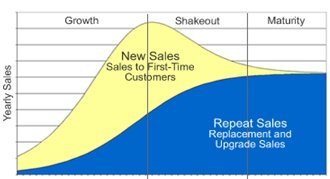
Source: Forio (2010).
First-time customers are concentrated in the first portion of the product-life cycle (Growth stage). During the Shakeout stage new sales decline and repeat sales start emerging. During maturity stage a firm experience highest concentration of repeat sales (Sääksvuori & Immonen, 2008).
Financial review for each product
Product X 5
The sales volume of the product in 2005 was 1,448,031 and this was a 55 percent increase from the previous year. The revenue volume collected during this year was 362, 007, 649 and this was a 55 percent increase from the previous year.
The costs incurred production and marketing of this product included: variable costs were 202, 724, 283 which was a 55 percent increase from the previous year, fixed costs 70 million, research and development costs were 6,666,667. The profits generated in the year were 82,616,699 and this was a 23 percent increase from the year 2004. The Economic Value Added was 80,696,699 and a capital charge of 1.92 million.
Product X6
Product X6 generated a sales volume of 908,627 in 2005; which was a 79 percent increase from the year 2004. Revenue volume of 363.45 million and this was a 79 percent increase as compared to the previous year.
The costs incurred by the company in production and marketing of product X6 were: variable costs 227,156,840-a 79 percent increase from the previous year, fixed costs 35 million, research and development costs 6,868,687. The profits generated for this product was 94,425,417 and this was a 26 percent increase in profitability. Economic Value Added during this financial period was 93, 22, 417 and a capital charge of 1.2 million.
Product X7
The sales volume of 244,244 was made in the year 2005; which was a 46 percent increase from the year 2004. Revenue volume generated during this year was 48,848,773- a 46 percent increase. Costs incurred by the firm in production and marketing of this product were: variable costs of 15.875 million, fixed costs 35 million, and research and development costs worth 6,464,646.
The company made losses worth 8,491,725 but this was a 55 percent decline in loses made from the previous year. A negative 49 percent change in Economic Value Added was made during this year while the capital charge was 2.4 million.
Combined financial review of products X5, X6 and X7
The revenue generated from the three products differed in the six years the study covered. In 2004 product X7 had the lowest price while product X6 had a higher price than X7. Product X5 generated the highest amount of revenue at the beginning of the study period. In the financial period 2004-2005 the three products indicated an increasing pattern in terms of the revenue generated from each product. This is explained in the graph below.
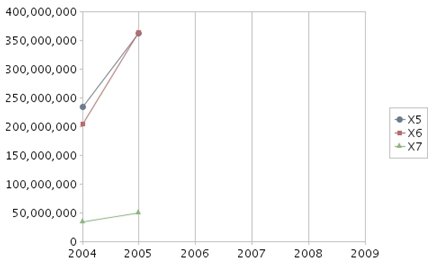
Source: Forio (2010).
Profitability of the three products showed an upward trend in the financial year 2004-2005. Products X6 and X5 had profits ranging from 20 million and above but product X7 generated profits losses which were approximately 20 million.
It is evident from the graph below that product X6 had the highest profits out of the three products while product X7 had the lowest profits. Towards the year 2005 product X6 had profits tending towards 100 million while product X5 had profits equivalent to 80 million. Product X7 still generated losses as the company approached year 2005; but the losses were declining.
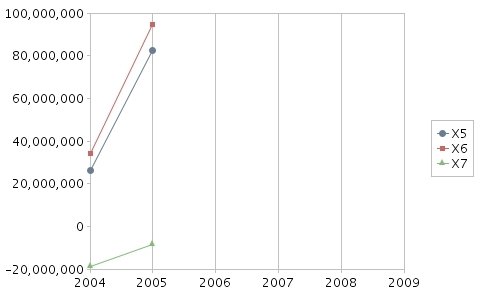
Source: Forio (2010).
Generally, product X6 had the best performance in the market while product X7 performed poorly during the financial period 2004-2005. General performance of the three products was good.
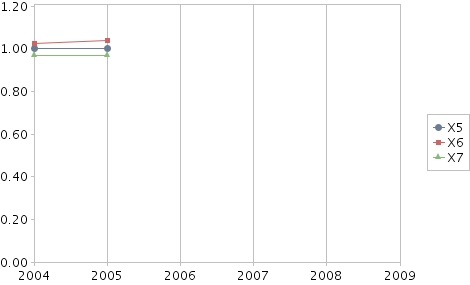
Source: Forio (2010).
Prices for the three products remained constant during the financial period 2004-2005. Product X6 had the highest price of $400 while product X7 had the least price of 200 during this period. Product X5 was sold at a constant price of 250.
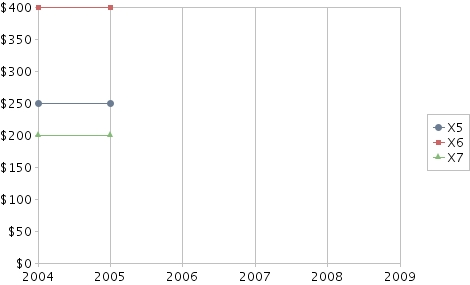
Source: Forio (2010).
Market review
New sales
The sales graph for the year 2004-2005 assumed an increasing trend for this period. Product X5 had the highest sales volume, followed by product X6 while product X7 had the least sales volume during this period. This information indicates that the company increased its volume of new sales for the three products.

Source: Forio (2010).
Market saturation during the year 2004-2005 for the three products was: 31% for product X5, 18% for product X6 and 3% for product X7. The three products indicated an increase in the market saturation in the financial period 2004-2005. Customer base for the three products showed an increasing trend. More first time customers were recorded during this period. Repeat sales also increased during this period for all the three products.
Proposal for an alternate strategy
Since product X5 is at the maturity stage, more funds should be provided for research and development to come up with differentiated features to attract more customers. The product has already attained its maturity stage and the prices for X5 can be increased since customers have already adopted the product and cannot be discouraged by price increase.
The management should increase the funds used in research and development to come up with better marketing strategies to attract more new customers. X7 is a new product in the market and most of the customers are new and the management should offer a lower price to attract more new customers and to encourage repeat purchase as the product enters the shakeout stage. Product X6 is at growth stage and more the prices should be maintained at the same level.
Customers for this product are either new customers or repeat customers and the management should increase the funds used in research and development for this product. By increasing research and development costs the management will improve the image of the product as well as find better promotional strategies to attract new customers and retain the existing customers.
References
Forio (2010). PDA SIM. Web.
Kurtz, D. L., MacKenzie, H. F., & Snow, K. (2009). Contemporary Marketing. Cengage Learning. ISBN 0176500030, 9780176500030.
Sääksvuori, A. & Immonen, A. (2008). Product Lifecycle Management. ISBN 3540781730, 9783540781738.
Stark, J. (2005). Product lifecycle management: 21st century paradigm for product realisation. Birkhäuser. ISBN 1852338105, 9781852338107.